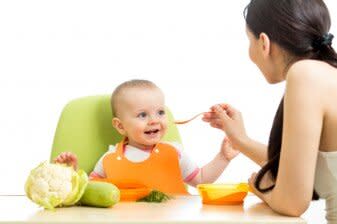Feeding Toddlers: 5 Common Mistakes and 5 Easy Fixes

I'm in a room full of parents, teaching them about feeding their toddlers. When I ask the parents to share their challenges, their stories sound exactly the same.
The toddler, as a baby, used to eat everything and now he shuns many vegetables and meat. Some days he eats a lot and on other days he barely touches his meals. What I say surprises most of the parents, and turns their feelings of guilt into hope. I tell that that what's happening is normal and that avoiding common feeding mistakes in toddlerhood will make a big difference in how their children eat over the long haul.
Here are 5 of the most common toddler feeding mistakes, followed by easy fixes.
1. Treating Picky Eating as a Problem: When a child's eating habits change, many parents panic, thinking something is wrong. This leads to labeling the child as "picky" followed by the feeding mistakes mentioned below.
Most parents don't realize that growth slows way down in the second year of life, leading to decreased appetite. During that time, the mind is also developing. Researchers believe picky eating may be an adaptive trait developed to protect mobile young children from consuming toxic plants. Studies show fear of new food peaks between 2 and 6 years of age and gradually declines as children age.
Easy Fix: When parents learn to expect picky eating as a normal part of development, they no longer blame themselves or their children, and mealtime is more enjoyable for everyone.
2. Giving Children too Much Choice: Does this sound familiar?
Parent: What do you want for lunch?
Child: I don't know.
Parent: Leftover lasagna?
Child: No. I don't like lasagna!
Parent: You just ate some last night. How about turkey sandwich?
Child: I want chicken nuggets! I want chicken nuggets!
Easy Fix: There's no need to consult your child who, by the way, enjoys saying the word "no," about what he'll eat at each meal. Simply plan and serve meals with at least one liked item, periodically offering your child's favorites. And if you do give choices, make them between two items: do you want a turkey sandwich or a peanut butter and jelly sandwich?
3. Getting the Jobs Mixed Up: Most feeding mistakes occur when a parent attempts to control a child's eating (required bites, micromanaging food choice) or the child is allowed too much control over food choices (short-order cooking, grazing on snacks all day).
Easy Fix: International Feeding Expert Ellyn Satter recommends a division of responsibility when feeding kids: Parents decide the what, when and where of feeding and children decide the whether and how much of eating. This melts away food battles and children eat better without all of that pressure.
4. Filling Up Bellies: About the size of a fist, toddlers' tummies fill up easily. A common mistake is to allow children to drink milk and juice throughout the day or snack between meals, decreasing appetite and intake at main meals.
Easy Fix: Feed your child with structure, meaning most meals and snacks occur in a designated area like the kitchen table around the same times each day. Keep milk intake to less than 24 ounces and 100% fruit juice to no more than 4-6 ounces.
5. Making More Better: During a meal out I overhear a dad saying "good job" after his 3-year old son finishes his pizza. This dad is not alone. According to a study published in
Appetite, 85% of parents use praise, reasoning and rewards to get young children to eat more at mealtime. The problem is this teaches children to ignore feelings of hunger and satiety and eat past fullness.
Easy Fix: Instead of commenting on how much children eat, encourage them to listen to their tummies. If they eat very little, remind them when the next meal is and to make sure they got enough to eat. When consistent feeding practices are in place, toddlers regulate their intake just fine. Just don't expect them to eat the same amounts from meal to meal.
If you can avoid common feeding mistakes, you toddler will grow into a school-aged kid who branches out with food, feels good about eating and gets the right amount for his or her body type. It's not always easy, but it's definitely worth it.
What challenges do you face when feeding your toddler?
Download our "First Bites to Finger Foods" guide to help make feeding time with your kiddos a little easier!
Image of mother feeding baby girl via shutterstock.
